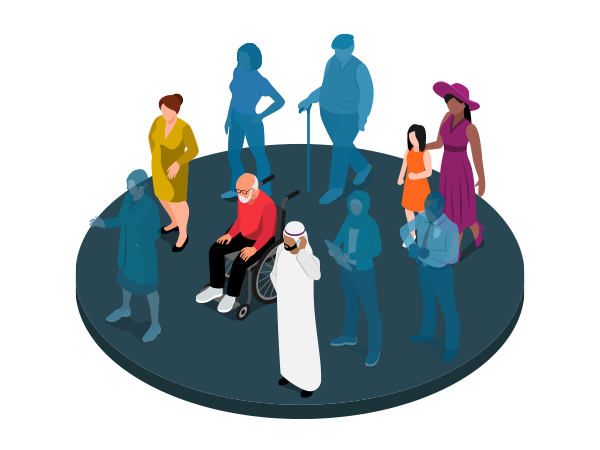
Increasing disease awareness and expanding diagnostic and treatment support is crucial to improving healthcare access for underserved populations with rare diseases.
For the estimated 350 million people worldwide with rare diseases, getting an accurate diagnosis and starting the right treatment is often a long and arduous process. And for underserved populations with rare diseases, those challenges are vastly magnified.
With more than 7,000 currently known rare diseases, the common timeline for diagnosis is between three and 15 years, according to the National Center for Advancing Translational Sciences. Correctly identifying, diagnosing and treating rare diseases depends on numerous factors, ranging from the support of various medical-specialty teams to leveraging expensive therapies. Those factors can make the treatment journey even more difficult for underserved populations who already experience socioeconomic, geographic and other barriers to accessing healthcare.
Here are three ways to help increase rare-disease awareness, expand patient support and tailor clinical-research opportunities to improve health equity for underserved populations with rare diseases.
1. Provide rare-disease education and support tools at the point of care
For underserved patients with rare diseases, it’s often a major challenge to simply access or get referrals to medical specialists who are equipped to identify their condition, says James O’Neill, Vice President of Media Services, Evoke.
“The only situation in which you’ll have a healthcare provider (HCP) who feels confident in diagnosing most of these rare diseases is if they’re a specialist,” O’Neill says. “This is challenging for underserved patients to access, not only from a healthcare-cost perspective, but also in the sense of having the necessary time and resources for navigating that journey.”
Social-determinant-of-health (SDOH) barriers such as lack of access to transportation for medical appointments, living far away from the closest appropriate specialists and high care costs can all prevent underserved populations from getting the specialty care they need to treat their rare disease. However, there are resources available to help them, from doctor discussion guides to copay-assistance programs. Getting those materials into patients’ hands in the moments before they speak with their HCP can empower them to ask about treatment options they may not have previously considered because of cost.
2. Increase physician understanding of rare-disease patients’ SDOH factors
Physicians aren’t always fully aware of a patient’s health circumstances, including the social determinants of health that can affect their treatment adherence. Especially with rare diseases, that lack of understanding can lead physicians to prescribe—or not prescribe—certain therapies for underserved populations based on their assumption that those patients won’t be able to maintain the treatment’s regimen, O’Neill says.
“For example, if a physician knows a second-line treatment requires a lot of adherence needs, they might not recommend it for underserved populations,” he says. “If the patient has had trouble keeping their appointments with them in the past, the HCP might think, ‘I’m not going to prescribe this treatment because there are too many steps [that the patient will] need to take before being able to receive it.’”
Encouraging HCPs to consider their patients’ SDOH, while also empowering patients to discuss the obstacles they face with treatment adherence can help HCPs better connect patients to the resources they need to start and stay on treatment. It’s also crucial to leverage the support of patient-advocacy groups to help underserved patients with rare diseases become better advocates for their own health, giving them the medical information and guidance they need to make better-informed healthcare decisions. These advocacy groups also provide a range of services to help rare-disease patients and their caregivers manage healthcare costs and find transportation assistance, among other offerings.
3. Engage underserved patients in rare-disease clinical-trial planning
While clinical research as a care option (CRAACO) is already difficult to achieve under the best of circumstances, underserved populations with rare diseases are doubly burdened. Understanding these patients and incorporating their feedback to increase their trial participation is, therefore, that much more important.
Interacting with rare disease patients during their online check-in process for doctor’s appointments is a promising way to find and engage with them to better understand the factors that affect their ability and willingness to participate in trials. A recent Phreesia survey of more than 4,300 patients found that patients trust digital appointment check-in more than any other media platform for clinical-trial information, positioning the point of care as an optimal place to engage with patients about clinical trials and research as a care option.
When it comes to engaging with underserved populations to design clinical trials that accommodate their unique needs, applying a patient-centric approach is essential, says Kelsey Shore, Research Manager, Phreesia.
“Patient centricity is about engaging patients on their own terms. This is key to finding patients and ensuring that diversity is prioritized in research, especially with rare diseases,” Shore says. “These patients spend an enormous amount of their time, money and effort on their healthcare. They don’t have a lot of time as it is, so understanding and integrating their real-world needs into clinical research as a care option is crucial for improving health equity.”
Find out how Phreesia can help you engage with and activate rare disease patients at critical moments in their healthcare journey.


